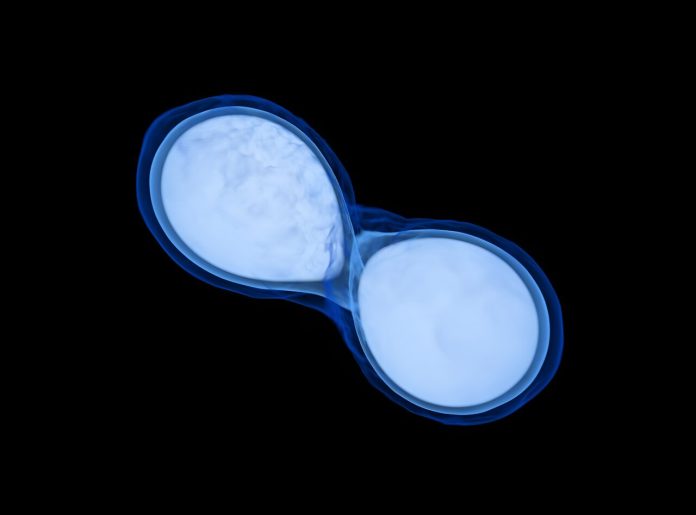
When stars collapse, they can leave behind incredibly dense, small, and cold remnants called neutron stars.
If two of these neutron stars are close together, they eventually spiral inward and collide. The point where they start to merge becomes extremely hot.
New simulations show that during these collisions, hot neutrinos—tiny particles that rarely interact with other matter—are created and briefly trapped at the interfaces of the merging stars.
These hot neutrinos remain out of equilibrium with the cold cores of the stars for 2 to 3 milliseconds.
During this time, they can weakly interact with the matter of the stars, helping to bring the particles back toward equilibrium. This discovery provides new insights into the physics of these powerful cosmic events.
A research team led by Penn State physicists published a paper on these simulations in the journal Physical Reviews Letters.
“For the first time in 2017, we observed signals, including gravitational waves, from a binary neutron star merger,” said Pedro Luis Espino, a postdoctoral researcher at Penn State and the University of California, Berkeley, who led the research.
“This sparked huge interest in studying binary neutron star astrophysics. Since we can’t reproduce these events in a lab, simulations based on Einstein’s theory of general relativity are our best way to understand them.”
Neutron stars are named for being composed almost entirely of neutrons, the uncharged particles that, along with protons and electrons, make up atoms.
Their incredible density—only black holes are smaller and denser—squeezes protons and electrons together, fusing them into neutrons.
A typical neutron star is only tens of kilometers across but has about 1.5 times the mass of our sun, which is about 1.4 million kilometers across. A teaspoon of neutron star material might weigh as much as a mountain.
“Before the merger, neutron stars are effectively cold,” said David Radice, an assistant professor of physics and astronomy at Penn State and a leader of the research team. “Even though they may be billions of degrees Kelvin, their incredible density means this heat contributes very little to the system’s energy.
As they collide, the interface of the colliding stars can heat up to trillions of degrees Kelvin. However, they are so dense that photons cannot escape to dissipate the heat; instead, they cool down by emitting neutrinos.”
During the collision, neutrons in the stars smash into each other and are blasted apart into protons, electrons, and neutrinos. What happens in those first moments after a collision has been an open question in astrophysics.
To answer that question, the research team created simulations that required massive computing power. These simulations modeled the merger of binary neutron stars and all the associated physics.
They showed for the first time that, however briefly, even neutrinos can be trapped by the heat and density of the merger. These hot neutrinos are out of equilibrium with the still cool cores of the stars and can interact with the matter of the stars.
“These extreme events stretch our understanding of physics and allow us to learn new things,” Radice said. “The out-of-equilibrium phase lasts only 2 to 3 milliseconds, but like temperature, time is relative here—the orbital period of the two stars before the merge can be as little as 1 millisecond.
This brief phase is when the most interesting physics occurs.”
The physical interactions during the merger can impact the types of signals observed on Earth from binary star mergers. “How the neutrinos interact with the matter and are eventually emitted can affect the oscillations of the merged remnants, impacting the electromagnetic and gravitational wave signals we detect,” Espino said.
“Next-generation gravitational-wave detectors could look for these signal differences. These simulations provide crucial insights and inform future experiments and observations.”
Source: Penn State.



